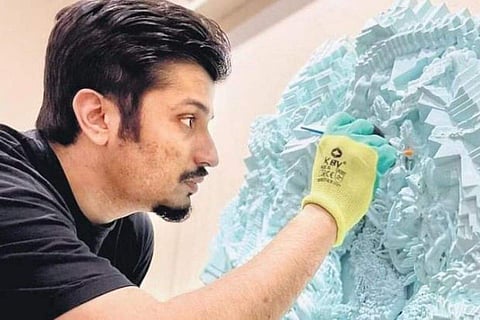
- LIFESTYLE
- FASHION
- FOOD
- ENTERTAINMENT
- EVENTS
- CULTURE
- VIDEOS
- WEB STORIES
- GALLERIES
- GADGETS
- CAR & BIKE
- SOCIETY
- TRAVEL
- NORTH EAST
- INDULGE CONNECT

"There was a need to automate,” Viraag Desai says, explaining his move from creating murals and collages to digital art. The 38-year-old, who counts American visual artist Mark Bradford and German painter Anselm Kiefer among his influences, is showcasing two 3D-printed plant resin works at Mumbai’s Chhatrapati Shivaji Maharaj Vastu Sangrahalaya (CSMVS).
In his two-foot interpretation of the Dashavatar of Vishnu titled 'Offerings of the Earth and Sea,' he incorporates all the flowers that are used to worship Vishnu and makes an ecological avatar. His second piece as part of the exhibition, Rhizome, uses Himalayan plant parts to give form to his reaction to Tibetan art, making a pagoda-like guardian object.
Also read: Adieu maestro artist Namboothiri
Would he call his practice mixed media? “I would rather say my present work comprises 3D printing and VR sculpting. These technologies are still in alpha stages,” he says.
“There’s a long process with different kinds of designing as part of the creation. It’s a winding routine and difficult for me to define with one random term,” says the Kolkata-based artist.
His art is syncretic, expertly and imaginatively bringing together the past and future. Some works remind one of the sculptures in ancient Greco-Roman cities, while others are as futuristic as transformers in space wars.
In April this year, Desai was chosen along with five others for the Julius Baer Next Generation Art Prize 2023, making him the first Indian to win the award. Instituted by Julius Baer, a leading Swiss wealth management group, it recognises young Asian artists who create digital art. Desai’s project, Pathfinder, which won him the prize, will be exhibited in a virtual showcase in a few months, and will later be turned into an offline exhibition in Singapore.
It was during the pandemic that the artist decided to merge technology and art. As the world went into forced isolation, Desai went into introspection. Till then his art involved making murals and collaging. “I would collect posters from the streets and put them together or make larger-than-life public art. But the pandemic put a stop to that,” he says. He moved from his studio in Mumbai to his home in Kolkata.
“I come from an engineering family, so building something with technology was natural for me. I first built a ‘drawing robot’, wherein I would input some information and it would draw something based on that. I got a 3D printer to test it out,” says Desai.
The success of this experiment made him realise that there was a world of possibility as far as technology and art were concerned. He continued his experiments working with computer-aided technology and finally came up with VR sculpting.
In fact, some of his early works during this period, showcased by Gallery Art Exposure in Kolkata in 2020 in an online exhibition—are dystopian in nature. The objects look fragmented, broken, and mummified. “It was a representation of my surroundings,” he says.
The artist believes that the art market at present has opened up to embrace technology. “Art has become more interactive now.
There is a constant engagement with the digital space. Even public appetite and appreciation are rising. They can identify with it,” he says but rues the fact that there are hardly any institutions that encourage the practice of digital art. “3D printing and robotics exist in some colleges, but it doesn’t connect with art,” he says.
“We should invest in such courses to encourage upcoming artists. Training in the digital space will make enthusiasts more professional and confident in their approach,” says the artist, who believes that global exposure, travelling and viewing works by renowned artists first-hand is another important step for budding artists of any genre.
Also read:
Which contemporary or modern work has influenced him the most? “Anish Kapoor’s Bean (CloudGate). It has become one with the identity of Chicago. Its sheer scale is mindnumbing,” he says. One piece of advice he has for upcoming artists? “If you want to hone your talent, you need to be part of as many art residencies as possible,” he says.